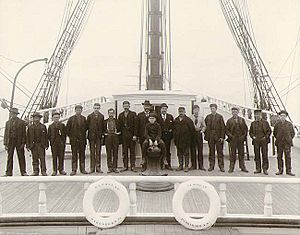Glooscap (ship) facts for kids
 |
|
Quick facts for kids History |
|
|---|---|
| Name | Glooscap |
| Port of registry | Parrsboro, Nova Scotia |
| Builder | Spencers Island Company, Spencer's Island, Nova Scotia |
| Launched | August 5, 1891 |
| Identification | |
| Fate | Converted to Gypsum barge 1914 |
| Notes | Official Number 100108 |
| General characteristics | |
| Tonnage | 1721 gross tons |
| Length | 238 ft (73 m) |
| Beam | 42.9 ft (13.1 m) |
| Depth | 23.9 ft |
| Decks | 2 |
| Propulsion | Sail |
| Sail plan | Full-rigged ship |
| Notes | Specifications from Glooscap 1914 Registry Form |
The Glooscap was a large sailing ship built in 1891. It was constructed in Spencer's Island, a small village in Nova Scotia, Canada. This area is located near the Minas Basin in the Bay of Fundy.
The ship was named after Glooscap. This is a special spiritual hero figure for the Mi'kmaq Indigenous people. The Glooscap was a very important ship for Spencer's Island. It showed how good the village was at building large ships.
Contents
A Giant of the Seas
The Glooscap was the last "square rigger" built along the Parrsboro Shore. This means it had square sails on all its masts. It was also the biggest ship ever built in Cumberland County, Nova Scotia.
First Voyage Around the World
In its first year, the Glooscap sailed all the way around the world. It carried goods to many different places. These included Liverpool in England, Cape Town in South Africa, Australia, and New York City in the United States. After this, it often sailed to the Pacific Ocean.
Sailing in a Changing World
The Glooscap was built when the "Age of Sail" was ending. This was a time when sailing ships were being replaced by steamships. Even so, the Glooscap was very successful. It made good money for its owners for twenty years.
The ship was commanded by two brothers, George T. Spicer and Dewis Spicer. They were both famous captains from Spencer's Island.
Later Life of the Ship
In 1914, the Glooscap was changed into a gypsum barge. A barge is a flat-bottomed boat used for carrying heavy goods. Gypsum is a soft mineral used in plaster and drywall.
Today, you can learn more about the Glooscap at two museums. There are exhibits at the lighthouse museum in Spencer's Island. You can also find information at the Age of Sail Heritage Centre in Port Greville.

